Hawk Breeding: An Insight into Their Nesting Secrets
Whether you’re studying the life cycles of Hawks or trying to reproduce them, studying their nesting and breeding habits is a must. Just like other avians, Hawks display exceptional breeding habits.
Hawk breeding starts with selecting a suitable nesting site where they lay eggs and raise their hatchlings. In general, they breed in Spring. The Hawks stick to one partner for their lifetime and create long-term pairs.
The breeding habits of Hawks have a significant effect on regulating the prey population and the overall ecosystem. Let’s get into the details of the breeding and nesting habits of Hawks to understand this fascinating creature well.
When Is the Hawk Breeding Season?

Typically, most Hawk species start mating in the spring or by the end of winter. They mate with their selected mates from the previous seasons or choose new mates when the weather gets warmer. The mating period of Hawk starts in February and lasts up to May.
Some hawk species, such as the Swainson’s Hawk and Sharp-shinned Hawk, start breeding earlier or later in the year. It depends on their migratory patterns, local climate, and availability of prey.
In regions closer to the equator, where the climate remains relatively stable throughout the year, some hawk species may not have a distinct breeding season. They can breed opportunistically whenever food resources are abundant.
Here’s the mating period of different Hawk species-
| Species | Breeding Season |
| Red-tailed Hawk | Late winter to early spring: February to April |
| Cooper’s Hawk | Late winter to early spring: February to May |
| Sharp-shinned Hawk | Late winter to early spring: February to April |
| Northern Goshawk | Spring: March-April |
| Swainson’s Hawk | Spring: April to June |
| Ferruginous Hawk (Largest hawk in the world) | Spring: late March or early April |
How Do Hawks Choose Their Mates?
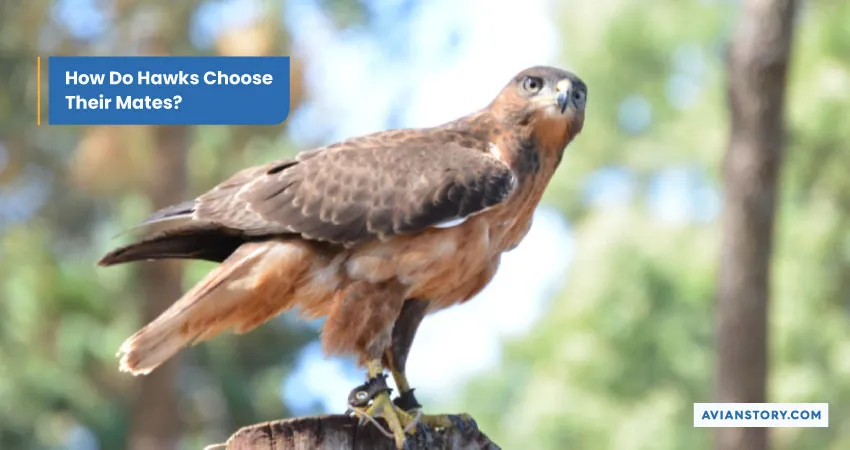
Hawks are known for their unique mating behavior and rituals. When the mating season arrives, the female starts building a nest and looking for a suitable partner. Below are some Hawk facts that affect the mate selection process-
Compatibility
Hawks prefer to choose partners compatible with their personalities. A more aggressive female hawk will look for a dominant male partner with great physical features. Besides, these birds choose partners based on their mating styles and behaviors.
Physical Features
Attractive and strong physical traits such as large size, strong wings, and shiny feathers are often preferable to Hawks. Female hawks usually choose males with large wings and overall strong build.
Bright Plumage
In birds, the color of plumage can define their health conditions. Hence, Hawks choose partners with colorful and bright plumage. Dull and gray plumage might be a sign of bad genetics and underlying health issues.
Vocals and Aerobic Display
Male hawks use their voice to attract females during the mating season. It’s a way of communicating and announcing their interest. Besides, they also display aerobic stunts to attract their chosen female partners for mating.
Do Hawks Mate for Life? – Hawk Mating Rituals

While most Hawks are monogamous and mate for life, some species don’t. Hawks mate with only one partner during the mating season and tend to stay together for a lifetime. If their partners die or go missing, they find a new one.
Now, let’s take a look at the mating facts, rituals, and behaviors of Hawks.
- Species like the Red-tailed Hawk and the Harris’s Hawk form long-term pair bonds that can last for life.
- However, other species, such as the Cooper’s Hawk and the Sharp-shinned Hawk, are serially monogamous. They form new pair bonds each breeding season.
- When the mating season arrives, the male Hawks select a territory and engage in aerial displays. They start soaring high in the sky and performing acrobatic flight maneuvers to attract the attention of potential mates. If you want to learn how to attract Hawks, take some notes from the male Hawks.
- Once a male hawk catches the attention of a female, he performs courtship flights to showcase his flying skills and strength. The male dives and soars back up repeatedly while calling out to the female.
- If interested, the female responds with similar flight patterns, indicating her interest. After a pair of hawks form a bond, they begin to build or repair a nest together.
Where Do Hawks Build Their Nests and Why?
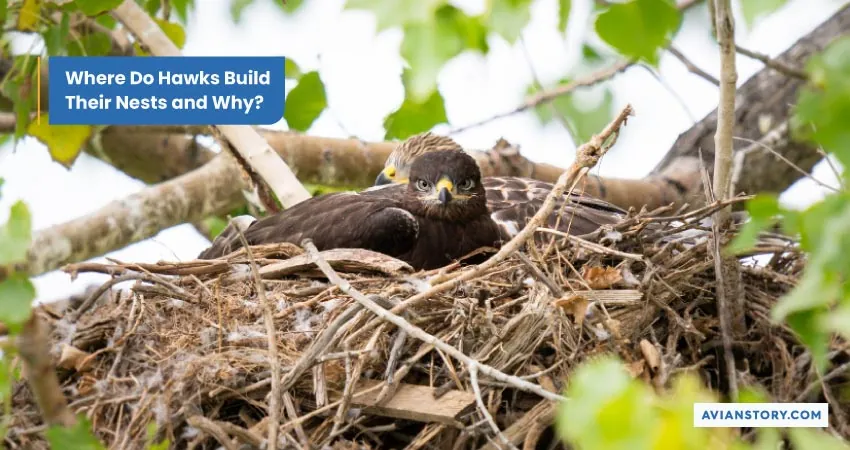
Similar to other preying birds, Hawks build their nests (commonly known as eyrie) in all trees around 120 ft above the ground. They often select large deciduous trees, coniferous trees, or even dead trees, depending on the species.
Some hawk species, such as the peregrine falcon, choose to nest on cliffs or rocky outcrops. They also build nests in buildings, poles, billboards, and other man-made structures. In some rare cases, they might build nests on the ground.
Below are some factors that influence the Hawks’ nesting behavior and site selection of Hawks-
Safety
While selecting their nesting location, Hawks choose the safest possible location. They pick nesting sites that offer protection from predators such as raccoons, snakes, or other birds. This is the major reason why Hawks’ nests are built in trees or on cliffs, as they are inaccessible to ground-based predators.
Even the Roadside Hawks, which are seen near the cities, prefer isolated trees for nesting.
Food Availability
Another key factor that decides where Hawks build their nests is the availability of food sources. Hawks select nesting locations near areas abundant in their preferred prey. It ensures a steady food supply during the breeding season when they need to feed both themselves and their offspring.
Environmental Conditions
Similar to other birds, Hawks consider environmental factors such as temperature, wind patterns, sunlight exposure, and the overall stability of the nesting site. These factors can impact the breeding phenology, survival, and development of eggs and chicks.
What Is the Nesting Process Like for Hawks?

During the mating season, Hawks start to build their nests. The process is a complex one with the participation of both males and females. Here’s how Hawks build their nests-
- First, the bird selects a suitable nesting site on a tree or a cliff. After that, the Hawk collects nesting materials such as twigs, sticks, moss, leaves, and grass.
- In general, the male hawk collects the materials while the female builds the nest or simply inspects the process. However, the roles might be different depending on the species.
- The nest has a strong base made of small sticks and twigs. Once the base is done, the female Hawk lines the nest with softer materials like fur or feathers.
- Hawk nests are round with a cup-shaped compression in the middle. A typical Hawk nest is 76 cm wide and 45 cm deep. It takes 4 to 5 weeks to complete building a nest.
How Many Eggs Do Hawks Typically Lay, and What Are Their Characteristics?
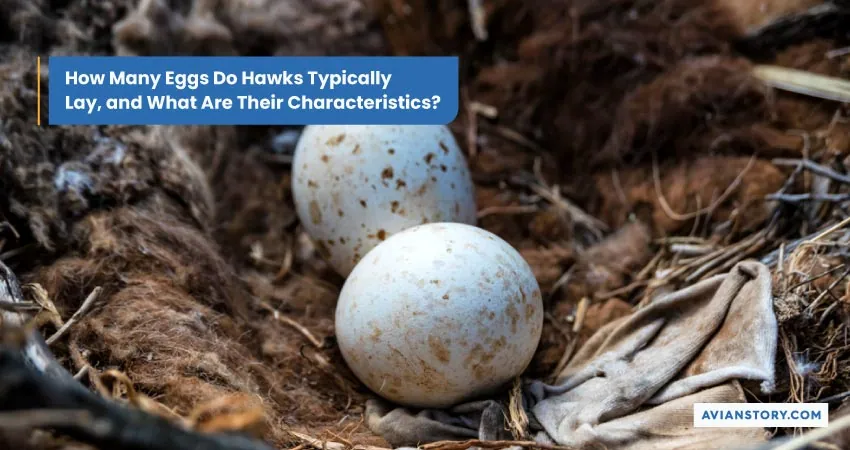
Hawks typically lay a clutch of eggs, with the number of eggs per clutch varying depending on the species. Clutch sizes can range from 1 to 6 eggs, with 2 to 3 eggs being the most common.
Here are some key characteristics of hawk eggs:
- Size: Hawk eggs are typically around 1.5 to 3 inches (3.8 to 7.6 centimeters) in length and about 1.5 to 2 inches (3.8 to 5 centimeters) in width. However, the size can vary depending on the species.
- Shape: Just like the other preying birds, Hawk eggs have an elongated oval shape. The exact shape can vary slightly between species.
- Color: In general, Hawk eggs feature a pale bluish-white or cream-colored background. Some hawk species lay eggs with a tint of light brown or greenish tones. The coloration is an important aspect of Hawk identification, and it helps the eggs blend in with the surrounding nest materials.
What Is the Incubation Process for Hawks?
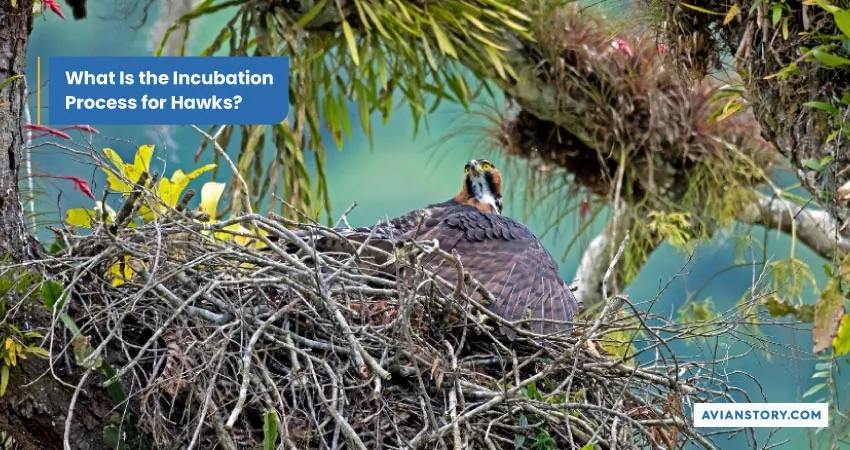
After laying eggs, the parent birds keep the eggs warm until they are ready to hatch. This process is known as incubation, and the incubation period in Hawks starts after laying the entire clutch.
On average, the incubation period for Hawks ranges from 30 to 45 days. However, this can vary depending on the type of Hawks.
During incubation, it’s mostly the female Hawk that sits on the eggs and keeps them warm. She uses her body heat to maintain a consistent temperature for the developing embryos. Also, the female hawk rotates the eggs regularly to ensure even heat distribution.
As for the male Hawk, he hunts to provide food for the female during incubation. However, in many species, both parents take turns incubating the eggs. While the male is incubating the eggs, the female takes a break to stretch her wings, preen the feathers, or engage in other necessary activities.
How Do Hawks Care for Their Young?
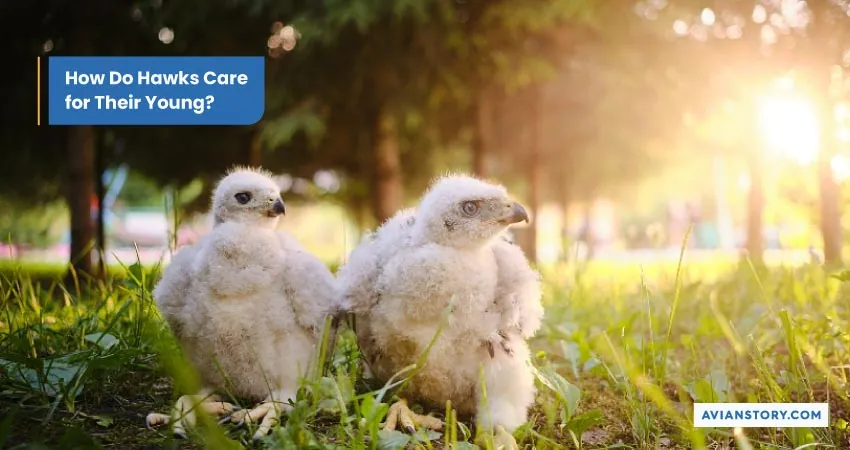
After the eggs are hatched, the young hawks or eyasses are small and not capable of flying or hunting. Hence, the eyasses depend on their parents until they learn to fledge.
However, the hatchlings grow rapidly and develop feathers in only a few weeks. Here’s how parent hawks care for their newborns-
Hunting and Feeding
Usually, the male hawk goes out to hunt and arrange food for the family while the female takes care of the eyasses. Baby hawks generally prefer rodents, lizards, small insects, and tiny mammals. The female parent feeds them around 10 times per day.
For about a month, the parents strip the food as the baby hawks don’t have any sharp beaks.
Fledge
When the baby Hawks take their first flight, they are called fledglings. As fledglings learn to fly, parent hawks provide guidance and demonstrate flying techniques. They accompany the young ones to show them how to soar, glide, and navigate through the air.
Hunting Lessons
Now that the eyasses have grown older, the parent Hawks gradually teach them some hunting skills. The adult hawks bring live prey to the nest so that the young hawks can practice their hunting techniques.
Parent hawks also teach fledglings important hunting skills, such as perching, scanning for prey, and swooping down to catch it.
Different Hawk Species Mating Seasons and Behaviors
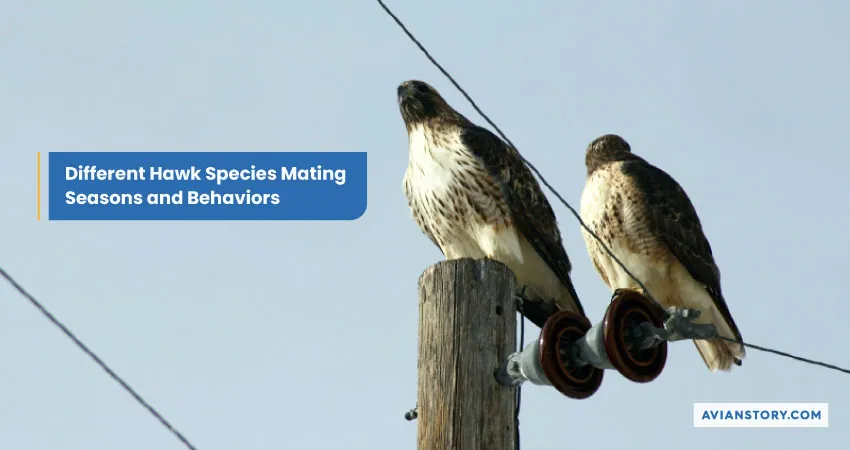
Now, let’s take a look at the mating behaviors of various hawk species-
- Cooper’s Hawk: As mentioned, Cooper’s Hawks mate in the late winter through the early spring. They have a variety of courtship displays, including sky-dancing, mutual circling, and food-sharing. The male will often bring the female a dead bird as a gift.
- Northern Harrier: Similar to the Cooper’s Hawks, the Northern Harrier also mates during the winter or spring. They often engage in an elaborate courtship display known as ‘sky-dancing’, where the male performs a series of aerobatic flight maneuvers.
- Sharp-Shinned Hawk: Typically, Sharp-Shinned Hawks mate during the spring months. This species is also known for its sky-dancing displays. The male will often fly around the female in circles while calling and displaying his feathers.
- Ferruginous Hawk: Unlike the other species, the mating season of Ferruginous Hawks starts late in the spring. The male Hawk often soars high in the sky and then dives toward the female, calling loudly.
- Harris’s Hawk: The mating season of Harris’s Hawks is usually in the late winter. During courtship, the male performs aerial displays, including steep dives and loops, to impress the female.
Hawks Breeding Compared With Other Birds of Prey
Although eagles, falcons, and owls are also preying birds, they have many differences in their breeding behaviors. Check out the following table to learn the similarities and differences between these birds of prey-
| Breeding Features | Hawks | Eagles | Falcons | Owls |
| Mating Season | February to May | Late April or May | Late March to May | January to March |
| Nesting | 120 feet above in tall trees | 50-125 above in large trees | 50-200 feet above tall structures | 40-70 feet above in trees |
| Egg | 1-6 eggs | 2 eggs | 3 or 4 eggs | 2-3 eggs |
| Hatching | 30-45 days | 35 days | 33-35 days | 33 days |
| Parental Care | 4 to 5 weeks by female or both parents | 4 to 5 weeks by females | Up to 5 weeks by females | 3 to 4 weeks by females |
How Does the Breeding Process Impact Hawk Populations?
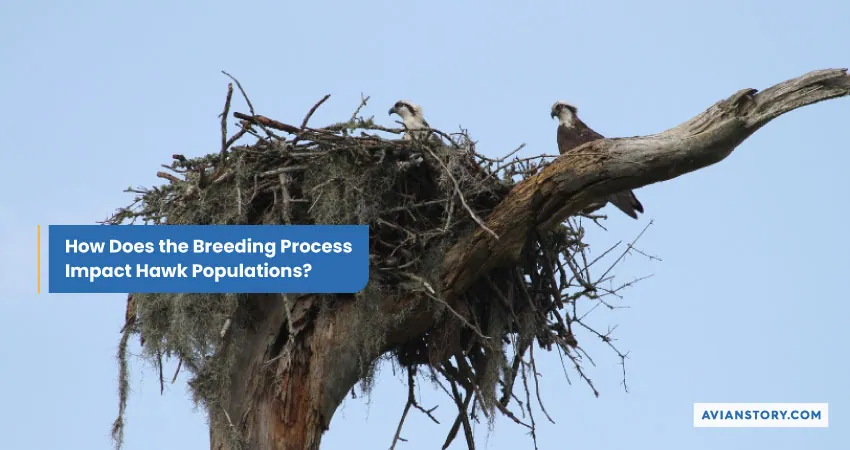
As preying birds, Hawks play a significant role in their local ecosystem. Successful breeding is crucial for the maintenance and growth of hawk populations. Here are the most notable impacts of Hawk breeding-
Survival of the Species
Research conducted by Justin H. White and other authors, published in the Journal of Urban Ecology, reveals that Hawks in general breed annually. Therefore, the success of their breeding has a big impact on the number of hawks that survive to the next year.
If there’s a scarcity of food and a suitable nesting location, the breeding might not be successful. As a result, the number of hawks in the population will decline.
Genetic Diversity
For the long-term survival of a species, genetic diversity is a must. Through natural breeding, the genetics of the newborn Hawks change over time. It helps the species to adapt according to environmental changes.
Unsuccessful breeding might lead to an increase in the risk of genetic disorders and reduced fitness in the population.
Balanced Ecosystem
As Hawks are preying birds, they play an important role in the ecosystem. They feed on other mammals, arthropods, avians, and reptiles. Therefore, Hawks contribute to controlling populations of small mammals, birds, and some harmful species.
Without successful breeding, there won’t be enough Hawks, and this harmony will be disturbed.
Wrapping Up!
When it comes to Hawk breeding, there are many fascinating factors to consider including their nesting behavior, mating rituals, and the difficulties of breeding. As discussed, Hawks breed in a unique way, and it has a significant effect on the environment. This complex process requires suitable habitats, ample food sources, and the presence of compatible mates.
Unfortunately, pollution, lack of trees in the cities, scarcity of food, etc., are major threats to the reproduction of the species. Besides, illegal hunting and killing of migratory Hawks can negatively impact the growth of the hawks’ population.
Therefore, we must increase awareness regarding the breeding and nesting behaviors of Hawks. Law enforcement and preventive steps will also help in protecting this fascinating species.
